wheel size FORD MUSTANG 2022 Warranty Guide
[x] Cancel search | Manufacturer: FORD, Model Year: 2022, Model line: MUSTANG, Model: FORD MUSTANG 2022Pages: 81, PDF Size: 1.96 MB
Page 7 of 81
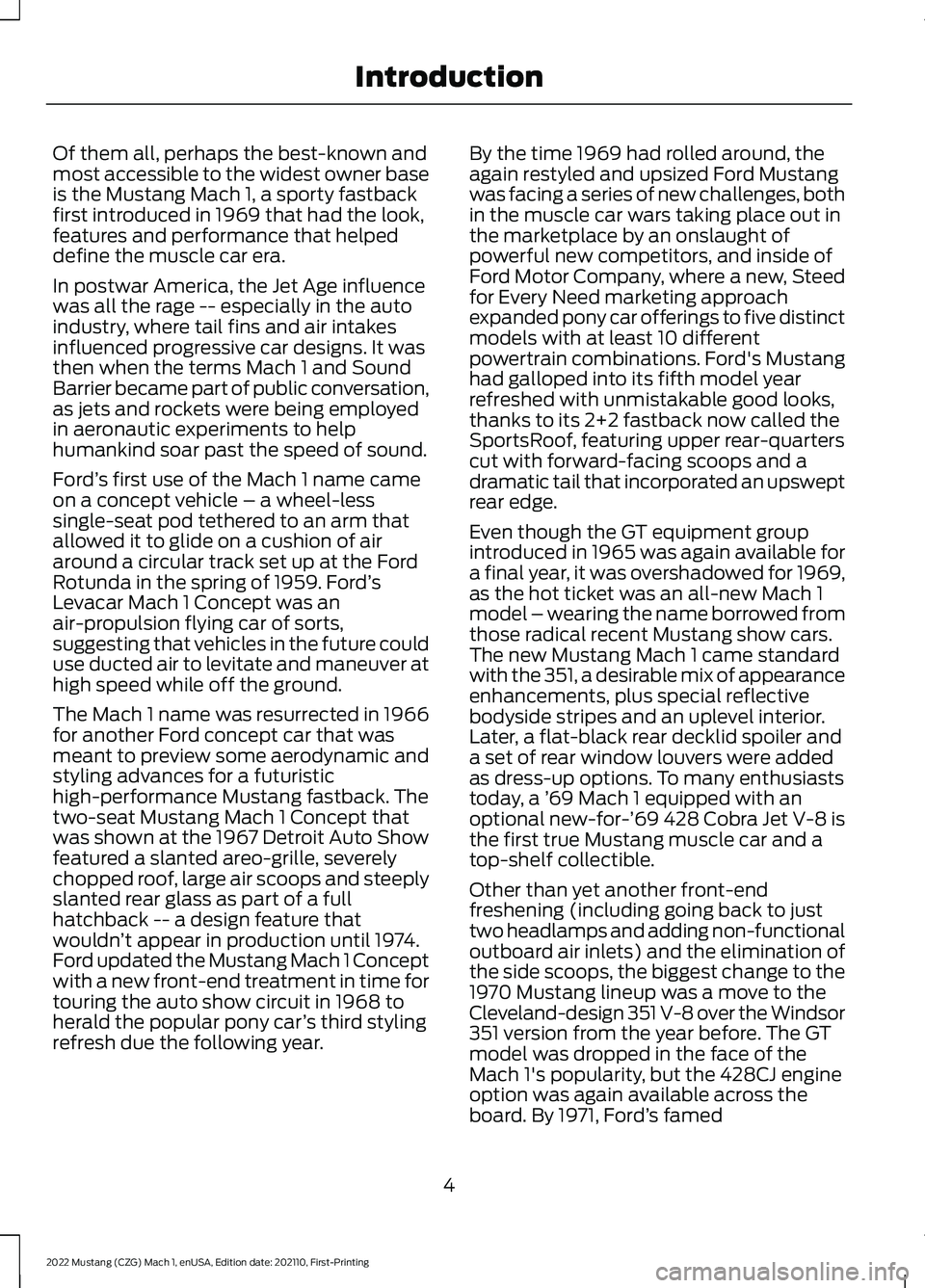
Of them all, perhaps the best-known and
most accessible to the widest owner base
is the Mustang Mach 1, a sporty fastback
first introduced in 1969 that had the look,
features and performance that helped
define the muscle car era.
In postwar America, the Jet Age influence
was all the rage -- especially in the auto
industry, where tail fins and air intakes
influenced progressive car designs. It was
then when the terms Mach 1 and Sound
Barrier became part of public conversation,
as jets and rockets were being employed
in aeronautic experiments to help
humankind soar past the speed of sound.
Ford
’s first use of the Mach 1 name came
on a concept vehicle – a wheel-less
single-seat pod tethered to an arm that
allowed it to glide on a cushion of air
around a circular track set up at the Ford
Rotunda in the spring of 1959. Ford ’s
Levacar Mach 1 Concept was an
air-propulsion flying car of sorts,
suggesting that vehicles in the future could
use ducted air to levitate and maneuver at
high speed while off the ground.
The Mach 1 name was resurrected in 1966
for another Ford concept car that was
meant to preview some aerodynamic and
styling advances for a futuristic
high-performance Mustang fastback. The
two-seat Mustang Mach 1 Concept that
was shown at the 1967 Detroit Auto Show
featured a slanted areo-grille, severely
chopped roof, large air scoops and steeply
slanted rear glass as part of a full
hatchback -- a design feature that
wouldn ’t appear in production until 1974.
Ford updated the Mustang Mach 1 Concept
with a new front-end treatment in time for
touring the auto show circuit in 1968 to
herald the popular pony car ’s third styling
refresh due the following year. By the time 1969 had rolled around, the
again restyled and upsized Ford Mustang
was facing a series of new challenges, both
in the muscle car wars taking place out in
the marketplace by an onslaught of
powerful new competitors, and inside of
Ford Motor Company, where a new, Steed
for Every Need marketing approach
expanded pony car offerings to five distinct
models with at least 10 different
powertrain combinations. Ford's Mustang
had galloped into its fifth model year
refreshed with unmistakable good looks,
thanks to its 2+2 fastback now called the
SportsRoof, featuring upper rear-quarters
cut with forward-facing scoops and a
dramatic tail that incorporated an upswept
rear edge.
Even though the GT equipment group
introduced in 1965 was again available for
a final year, it was overshadowed for 1969,
as the hot ticket was an all-new Mach 1
model – wearing the name borrowed from
those radical recent Mustang show cars.
The new Mustang Mach 1 came standard
with the 351, a desirable mix of appearance
enhancements, plus special reflective
bodyside stripes and an uplevel interior.
Later, a flat-black rear decklid spoiler and
a set of rear window louvers were added
as dress-up options. To many enthusiasts
today, a ’
69 Mach 1 equipped with an
optional new-for-’ 69 428 Cobra Jet V-8 is
the first true Mustang muscle car and a
top-shelf collectible.
Other than yet another front-end
freshening (including going back to just
two headlamps and adding non-functional
outboard air inlets) and the elimination of
the side scoops, the biggest change to the
1970 Mustang lineup was a move to the
Cleveland-design 351 V-8 over the Windsor
351 version from the year before. The GT
model was dropped in the face of the
Mach 1's popularity, but the 428CJ engine
option was again available across the
board. By 1971, Ford ’s famed
4
2022 Mustang (CZG) Mach 1, enUSA, Edition date: 202110, First-Printing Introduction
Page 55 of 81
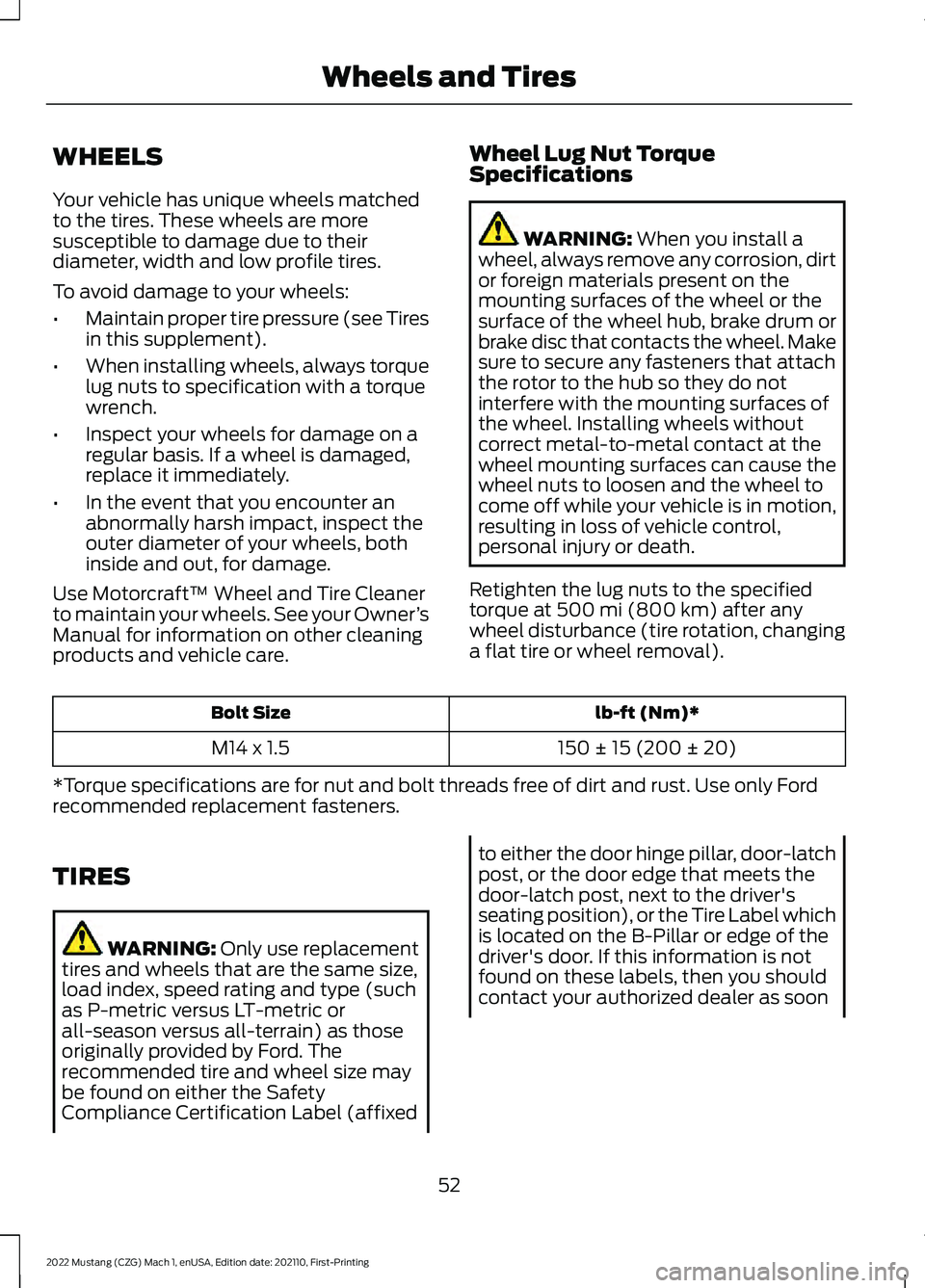
WHEELS
Your vehicle has unique wheels matched
to the tires. These wheels are more
susceptible to damage due to their
diameter, width and low profile tires.
To avoid damage to your wheels:
•
Maintain proper tire pressure (see Tires
in this supplement).
• When installing wheels, always torque
lug nuts to specification with a torque
wrench.
• Inspect your wheels for damage on a
regular basis. If a wheel is damaged,
replace it immediately.
• In the event that you encounter an
abnormally harsh impact, inspect the
outer diameter of your wheels, both
inside and out, for damage.
Use Motorcraft™ Wheel and Tire Cleaner
to maintain your wheels. See your Owner ’s
Manual for information on other cleaning
products and vehicle care. Wheel Lug Nut Torque
Specifications WARNING: When you install a
wheel, always remove any corrosion, dirt
or foreign materials present on the
mounting surfaces of the wheel or the
surface of the wheel hub, brake drum or
brake disc that contacts the wheel. Make
sure to secure any fasteners that attach
the rotor to the hub so they do not
interfere with the mounting surfaces of
the wheel. Installing wheels without
correct metal-to-metal contact at the
wheel mounting surfaces can cause the
wheel nuts to loosen and the wheel to
come off while your vehicle is in motion,
resulting in loss of vehicle control,
personal injury or death.
Retighten the lug nuts to the specified
torque at
500 mi (800 km) after any
wheel disturbance (tire rotation, changing
a flat tire or wheel removal). lb-ft (Nm)*
Bolt Size
150 ± 15 (200 ± 20)
M14 x 1.5
*Torque specifications are for nut and bolt threads free of dirt and rust. Use only Ford
recommended replacement fasteners.
TIRES WARNING:
Only use replacement
tires and wheels that are the same size,
load index, speed rating and type (such
as P-metric versus LT-metric or
all-season versus all-terrain) as those
originally provided by Ford. The
recommended tire and wheel size may
be found on either the Safety
Compliance Certification Label (affixed to either the door hinge pillar, door-latch
post, or the door edge that meets the
door-latch post, next to the driver's
seating position), or the Tire Label which
is located on the B-Pillar or edge of the
driver's door. If this information is not
found on these labels, then you should
contact your authorized dealer as soon
52
2022 Mustang (CZG) Mach 1, enUSA, Edition date: 202110, First-Printing Wheels and Tires
Page 56 of 81
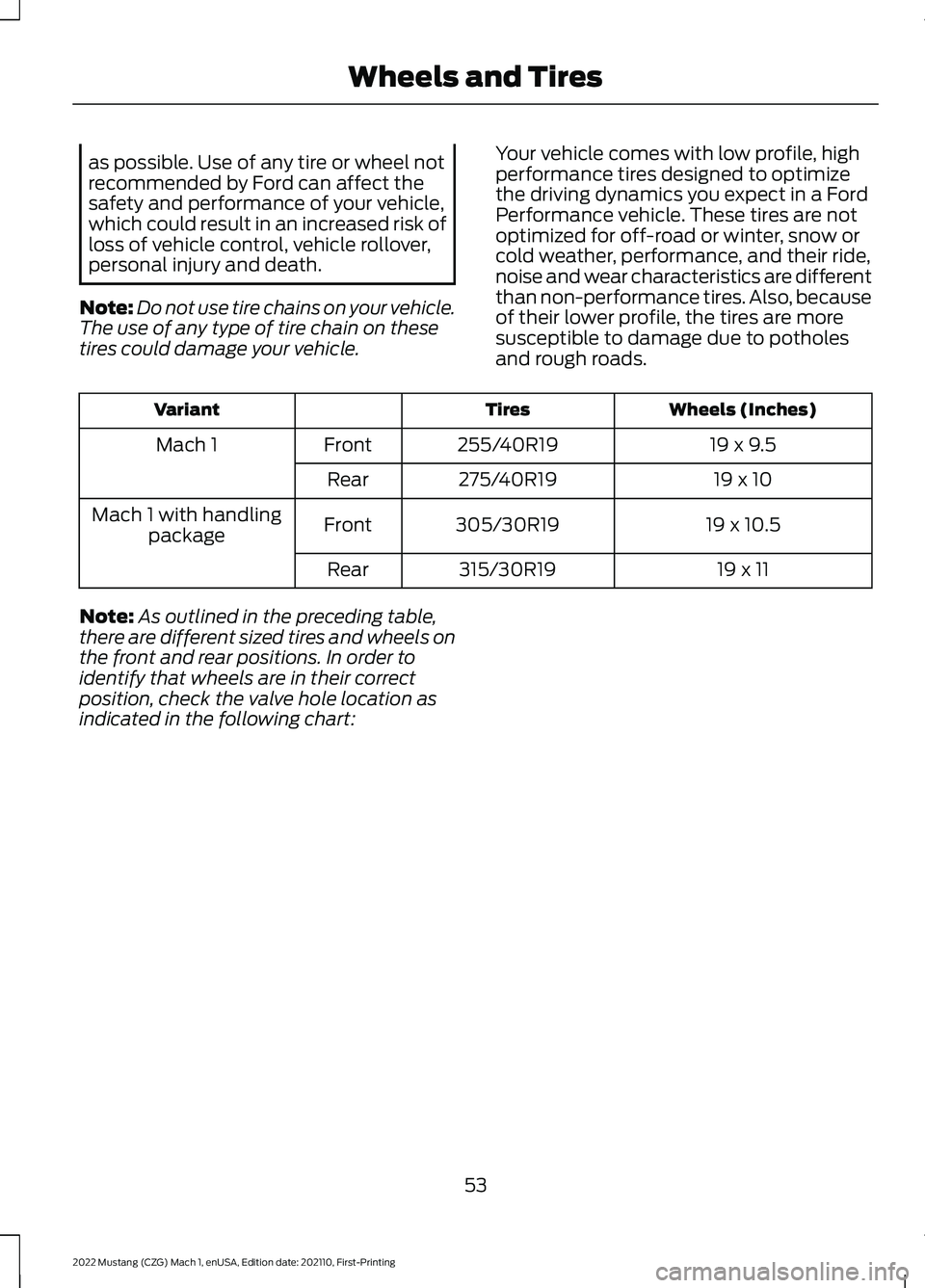
as possible. Use of any tire or wheel not
recommended by Ford can affect the
safety and performance of your vehicle,
which could result in an increased risk of
loss of vehicle control, vehicle rollover,
personal injury and death.
Note: Do not use tire chains on your vehicle.
The use of any type of tire chain on these
tires could damage your vehicle. Your vehicle comes with low profile, high
performance tires designed to optimize
the driving dynamics you expect in a Ford
Performance vehicle. These tires are not
optimized for off-road or winter, snow or
cold weather, performance, and their ride,
noise and wear characteristics are different
than non-performance tires. Also, because
of their lower profile, the tires are more
susceptible to damage due to potholes
and rough roads. Wheels (Inches)
Tires
Variant
19 x 9.5
255/40R19
Front
Mach 1
19 x 10
275/40R19
Rear
19 x 10.5
305/30R19
Front
Mach 1 with handling
package
19 x 11
315/30R19
Rear
Note: As outlined in the preceding table,
there are different sized tires and wheels on
the front and rear positions. In order to
identify that wheels are in their correct
position, check the valve hole location as
indicated in the following chart:
53
2022 Mustang (CZG) Mach 1, enUSA, Edition date: 202110, First-Printing Wheels and Tires
Page 57 of 81
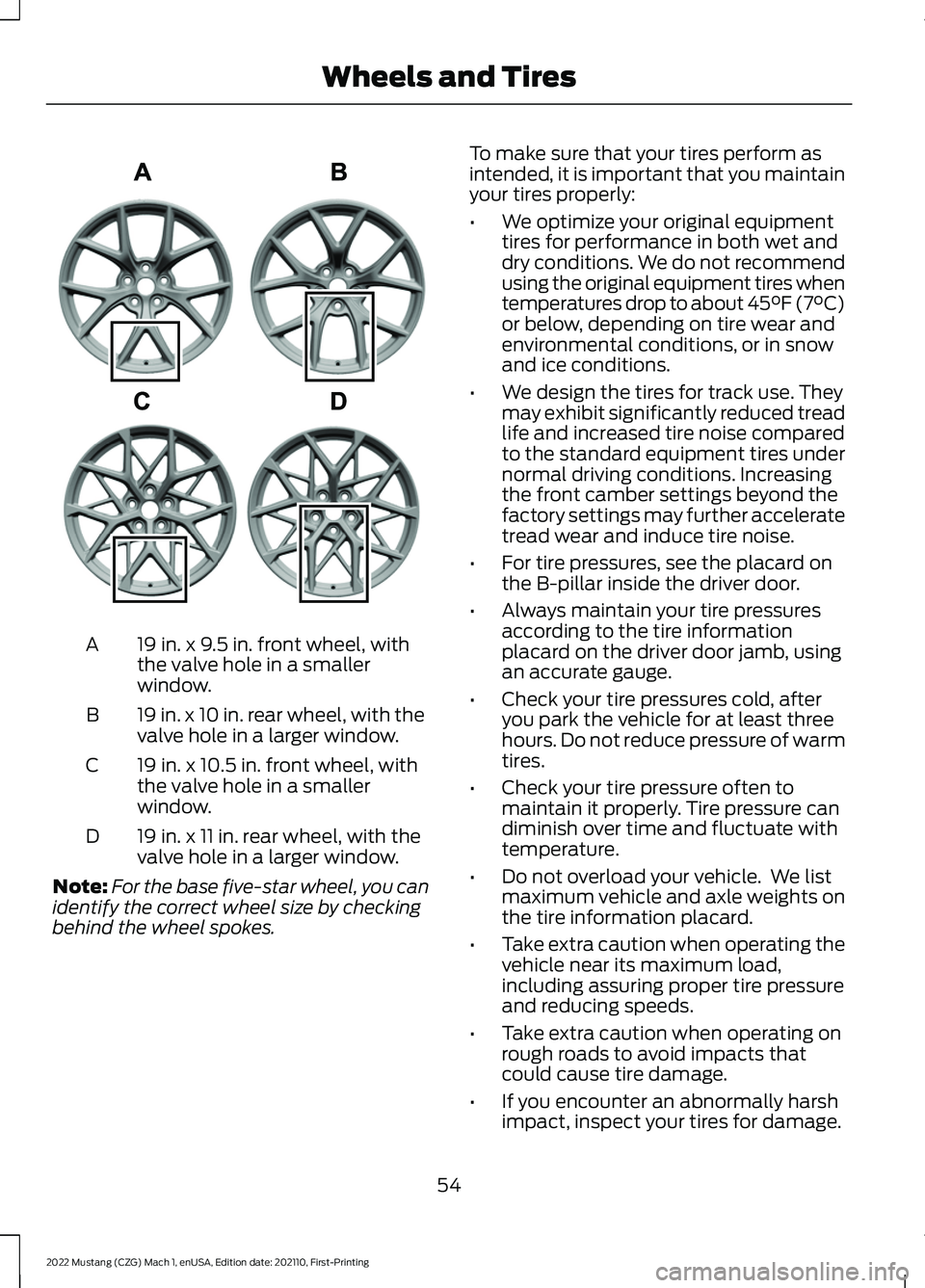
19 in. x 9.5 in. front wheel, with
the valve hole in a smaller
window.
A
19 in. x 10 in. rear wheel, with the
valve hole in a larger window.
B
19 in. x 10.5 in. front wheel, with
the valve hole in a smaller
window.
C
19 in. x 11 in. rear wheel, with the
valve hole in a larger window.
D
Note: For the base five-star wheel, you can
identify the correct wheel size by checking
behind the wheel spokes. To make sure that your tires perform as
intended, it is important that you maintain
your tires properly:
•
We optimize your original equipment
tires for performance in both wet and
dry conditions. We do not recommend
using the original equipment tires when
temperatures drop to about 45°F (7°C)
or below, depending on tire wear and
environmental conditions, or in snow
and ice conditions.
• We design the tires for track use. They
may exhibit significantly reduced tread
life and increased tire noise compared
to the standard equipment tires under
normal driving conditions. Increasing
the front camber settings beyond the
factory settings may further accelerate
tread wear and induce tire noise.
• For tire pressures, see the placard on
the B-pillar inside the driver door.
• Always maintain your tire pressures
according to the tire information
placard on the driver door jamb, using
an accurate gauge.
• Check your tire pressures cold, after
you park the vehicle for at least three
hours. Do not reduce pressure of warm
tires.
• Check your tire pressure often to
maintain it properly. Tire pressure can
diminish over time and fluctuate with
temperature.
• Do not overload your vehicle. We list
maximum vehicle and axle weights on
the tire information placard.
• Take extra caution when operating the
vehicle near its maximum load,
including assuring proper tire pressure
and reducing speeds.
• Take extra caution when operating on
rough roads to avoid impacts that
could cause tire damage.
• If you encounter an abnormally harsh
impact, inspect your tires for damage.
54
2022 Mustang (CZG) Mach 1, enUSA, Edition date: 202110, First-Printing Wheels and TiresE340110
Page 58 of 81
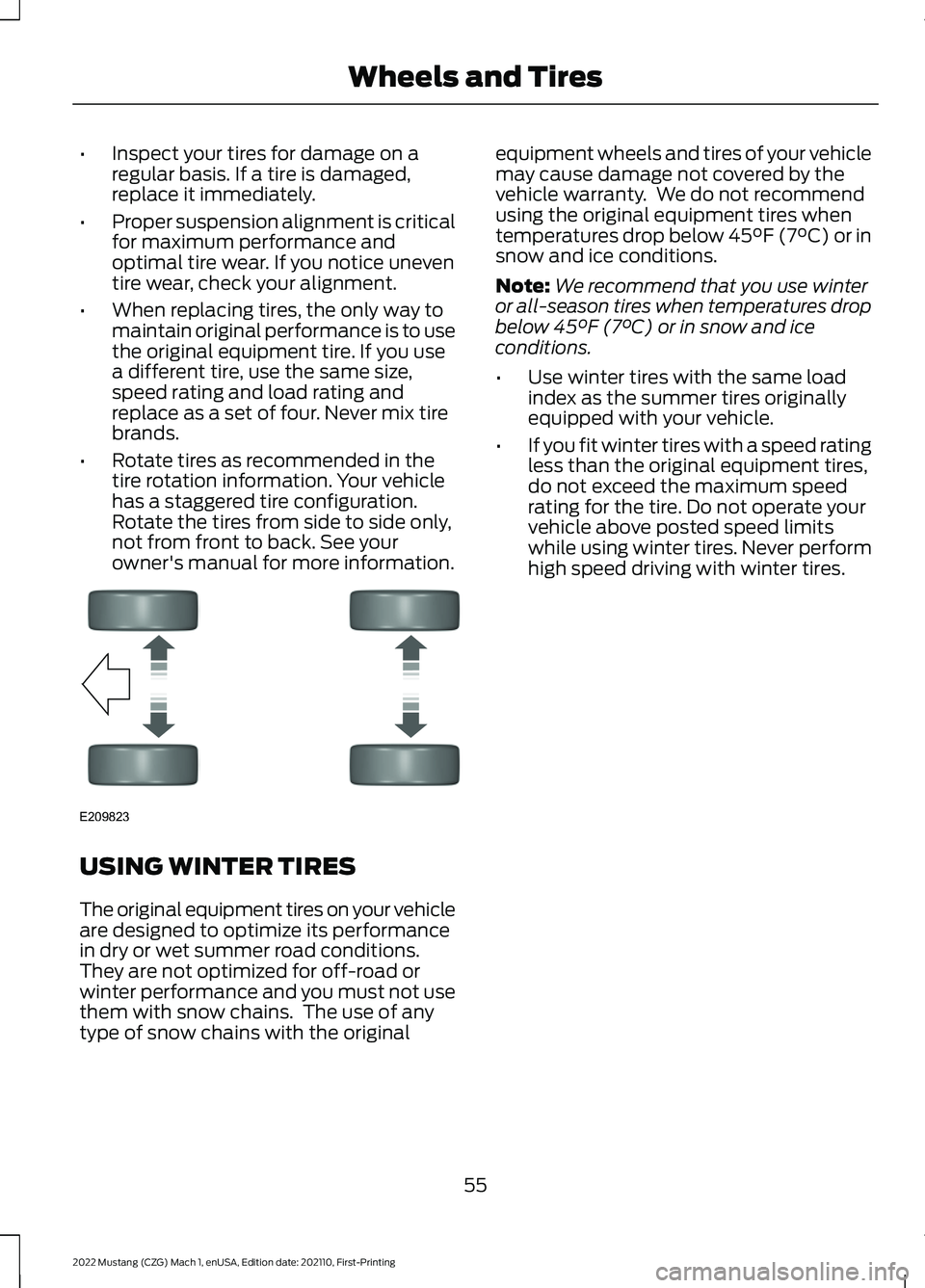
•
Inspect your tires for damage on a
regular basis. If a tire is damaged,
replace it immediately.
• Proper suspension alignment is critical
for maximum performance and
optimal tire wear. If you notice uneven
tire wear, check your alignment.
• When replacing tires, the only way to
maintain original performance is to use
the original equipment tire. If you use
a different tire, use the same size,
speed rating and load rating and
replace as a set of four. Never mix tire
brands.
• Rotate tires as recommended in the
tire rotation information. Your vehicle
has a staggered tire configuration.
Rotate the tires from side to side only,
not from front to back. See your
owner's manual for more information. USING WINTER TIRES
The original equipment tires on your vehicle
are designed to optimize its performance
in dry or wet summer road conditions.
They are not optimized for off-road or
winter performance and you must not use
them with snow chains. The use of any
type of snow chains with the original equipment wheels and tires of your vehicle
may cause damage not covered by the
vehicle warranty. We do not recommend
using the original equipment tires when
temperatures drop below 45°F (7°C) or in
snow and ice conditions.
Note:
We recommend that you use winter
or all-season tires when temperatures drop
below 45°F (7°C) or in snow and ice
conditions.
• Use winter tires with the same load
index as the summer tires originally
equipped with your vehicle.
• If you fit winter tires with a speed rating
less than the original equipment tires,
do not exceed the maximum speed
rating for the tire. Do not operate your
vehicle above posted speed limits
while using winter tires. Never perform
high speed driving with winter tires.
55
2022 Mustang (CZG) Mach 1, enUSA, Edition date: 202110, First-Printing Wheels and TiresE209823